Python实战案例系列(一)
本节目录
- 烟草扫码数据统计
- 奖学金统计
实战一、烟草扫码数据统计
1. 需求分析
根据扫码信息在数据库文件中匹配相应规格详细信息,并进行个数统计
条码库.xls
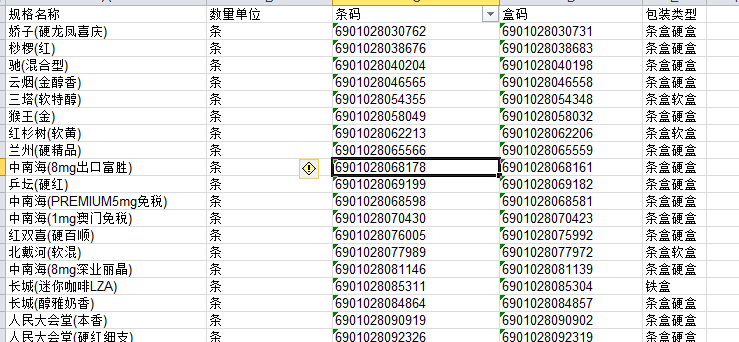
扫码.xlsx
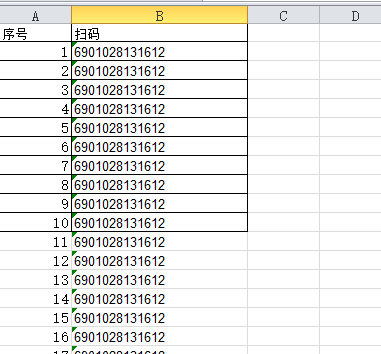
一个条码对应多个规格名称.xlsx

2. 代码实现
# -*- coding: utf-8 -*- """
Datetime: 2020/08/05
Author: ZhangYafei
Description: 扫码数据统计
pip install -i https://pypi.tuna.tsinghua.edu.cn/simple xlrd xlwt pandas
python scan_code_stat.py -d 条码库文件路径 -f 扫码文件路径 -o 统计结果输出文件路径
或者
python scan_code_stat.py
默认为 -d 条码库 -f 扫码 -o 统计结果.xlsx
"""
from functools import wraps
from collections import defaultdict import pandas as pd
import os
import time
from optparse import OptionParser def get_option():
opt_parser = OptionParser()
opt_parser.add_option('-d', '--infile1', action='store', type="string", dest='code_db_file', default='条码库')
opt_parser.add_option('-f', '--infile2', action='store', type="string", dest='code_file', default='扫码')
opt_parser.add_option("-o", "--outfile", action="store", dest="output_file", default='统计结果.xlsx', help='输出文件路径')
option, args = opt_parser.parse_args()
return option.code_db_file, option.code_file, option.output_file def timeit(func):
"""
装饰器: 判断函数执行时间
:param func:
:return:
""" @wraps(func)
def inner(*args, **kwargs):
start = time.time()
ret = func(*args, **kwargs)
end = time.time() - start
if end < 60:
print(f'花费时间: {round(end, 2)}秒')
else:
min, sec = divmod(end, 60)
print(f'花费时间 {round(min)}分 {round(sec, 2)}秒')
return ret return inner def read_file(file_name: str, converters: dict = None):
if file_name.endswith('xls') or file_name.endswith('xlsx'):
return pd.read_excel(file_name, converters=converters) if converters else pd.read_excel(file_name)
if os.path.exists(f'{file_name}.xls'):
return pd.read_excel(f'{file_name}.xls', converters=converters) if converters else pd.read_excel(f'{file_name}.xls')
elif os.path.exists(f'{file_name}.xlsx'):
return pd.read_excel(f'{file_name}.xlsx', converters=converters) if converters else pd.read_excel(f'{file_name}.xls') @timeit
def main():
code_db_file, code_file, output_file = get_option()
# 1. 读取条码库并处理为 规格名称 扫码 类型 三列
print('正在读取条码库数据---')
code_db = read_file(code_db_file, converters={'条码': str, '盒码': str})
new_code_db = code_db.dropna(subset=['条码'])[['规格名称', '条码']].copy().rename(columns={'条码': '扫码'})
new_code_db['类型'] = '条码'
new_code_db2 = code_db.dropna(subset=['盒码'])[['规格名称', '盒码']].copy().rename(columns={'盒码': '扫码'})
new_code_db2['类型'] = '盒码'
new_code_db = new_code_db.append(new_code_db2)
new_code_db['扫码'] = new_code_db['扫码'].str.strip()
new_code_db = new_code_db[(new_code_db['扫码'] != '(null)') & (new_code_db['扫码'] != '无')]
code_type_duplicated = set(new_code_db.loc[new_code_db.duplicated(subset=['扫码', '类型']), '扫码'].to_list())
name_dict = defaultdict(set)
code_name_dict = defaultdict(list)
code_name_dict2 = {}
new_code_db2 = new_code_db.set_index(keys=['扫码', '规格名称'])
for code, name in new_code_db2.loc[code_type_duplicated, :].index:
name_dict[code].add(name) def build_dict(row):
if pd.notna(row['规格名称']):
code_name_dict2[row['扫码']] = row['规格名称'] print('正在读取 一个条码对应多个规格名称.xlsx ---')
total_duplicated_code_df = read_file('一个条码对应多个规格名称.xlsx')
if len(total_duplicated_code_df[total_duplicated_code_df['规格名称'].notna()]) > 0:
total_duplicated_code_df.apply(build_dict, axis=1)
# data = []
for code in name_dict:
if len(name_dict[code]) > 1:
code_name_dict[code] = list(name_dict[code])
# data.append({'扫码': code, '规格名称[多]': ';;'.join(name_dict[code]), '规格名称': ''})
# total_duplicated_code_df = pd.DataFrame(data=data)
# total_duplicated_code_df.to_excel('一个条码对应多个规格名称.xlsx', index=False) # 2. 将条码和盒码相同的只保留条码
name_duplicated = new_code_db.loc[(new_code_db['扫码'].duplicated()) & (~new_code_db.duplicated(subset=['扫码', '类型'])), '扫码']
new_code_db = new_code_db[~((new_code_db['扫码'].isin(name_duplicated)) & (new_code_db['类型'] == '盒码'))]
duplicated_tiao_he_code_list = new_code_db.loc[new_code_db['扫码'].isin(name_duplicated), '扫码']
# 3. 读取扫码数据并与条码库合并(左连接)
print('正在读取扫码数据---')
scan_code = read_file(file_name=code_file, converters={'扫码': str})
scan_code_count = scan_code['扫码'].value_counts()
scan_code_count = scan_code_count.reset_index().rename(columns={'index': '扫码', '扫码': '数量'})
scan_code_match_data = pd.merge(scan_code_count, new_code_db, on='扫码')
scan_code_match_data.drop_duplicates(inplace=True)
if len(scan_code_match_data.index) == 0:
print('数据匹配结果为空,请重新检查您的数据')
return
duplicated_code_list = scan_code_match_data['扫码'][scan_code_match_data['扫码'].duplicated()]
print(f'{code_file}文件中有 【{len(duplicated_code_list)}】 项扫码匹配到数据库中的规格名称存在重复项 需手动选择匹配')
# 4. 对于重复的扫码 手动匹配重复的规格名称
for index, code in enumerate(duplicated_code_list):
if code in code_name_dict2:
select_name = code_name_dict2[code]
else:
names = code_name_dict[code]
names_str = ''
for n, name in enumerate(names):
names_str += f'【{n}】 {name}\t'
while True:
select_num = int(input(f'扫码{index+1} {code}\t请选择对应规格名称的序号\n{names_str}\n请输入(数字【0-{len(names)-1}】: '))
if select_num >= len(names):
print(f'输入序号超出指定范围(0-{len(names)-1})\t请重新输入')
else:
select_name = names[select_num]
break
print(f'{code} 将匹配的规格名称是: {select_name}')
scan_code_match_data = scan_code_match_data[~((scan_code_match_data['扫码'] == code) & (scan_code_match_data['规格名称'] != select_name))]
scan_code_match_data.set_index(keys=['类型', '规格名称', '扫码'], inplace=True)
code_list = scan_code_match_data.index.get_level_values(2).to_list()
code_types = scan_code_match_data.index.get_level_values(0)
# 5. 计算结果文件所需格式,并导出
res_df = pd.DataFrame(columns=['规格名称', '盒包数量', '条包数量'], index=code_list)
if '条码' in code_types:
for code_type, name, code in scan_code_match_data.loc[code_types == '条码', '数量'].index:
res_df.loc[code, '规格名称'] = name
res_df.loc[code, '条包数量'] = scan_code_match_data.loc[('条码', name, code), '数量'] if '盒码' in code_types:
for code_type, name, code in scan_code_match_data.loc[code_types == '盒码', '数量'].index:
res_df.loc[code, '规格名称'] = name
res_df.loc[code, '盒包数量'] = scan_code_match_data.loc[('盒码', name, code), '数量'] res_df.dropna(subset=['条包数量', '盒包数量'], inplace=True, how='all')
res_df.fillna(0, inplace=True) # 6. 导出文件 并给重复的规格名称添加颜色
duplicated_name_list = res_df.loc[res_df['规格名称'].duplicated(), '规格名称'].to_list() writer = pd.ExcelWriter(output_file, engine='xlsxwriter')
res_df.to_excel(excel_writer=writer, index_label='扫码') workbook = writer.book
worksheet = writer.sheets['Sheet1'] format1 = workbook.add_format({'bold': True,
'bg_color': '#FFD700',
'font_color': '#DC143C'})
format2 = workbook.add_format({'bold': True,
'bg_color': '#90EE90',
'font_color': '#1E90FF'})
format3 = workbook.add_format({'bold': True,
'bg_color': 'red',
'font_color': 'white'})
format4 = workbook.add_format({'align': 'center'}) worksheet.set_column(0, len(res_df.index), cell_format=format4) for name in duplicated_name_list:
worksheet.conditional_format(1, 1, len(res_df.index), 1,
{'type': 'text',
'criteria': 'containing',
'value': name,
'format': format1})
for code in duplicated_tiao_he_code_list:
worksheet.conditional_format(1, 0, len(res_df.index), 0,
{'type': 'text',
'criteria': 'containing',
'value': code,
'format': format2}) for code in duplicated_code_list:
worksheet.conditional_format(1, 0, len(res_df.index), 0,
{'type': 'text',
'criteria': 'containing',
'value': code,
'format': format3}) writer.save() print('\n################** 开始打印运行日志 **##################')
print(f'数据已处理完成! 并保存到文件: {output_file}')
print('【注:1.条码和盒码相同的标注为蓝色背景 2.规格名称相同,扫码不同的标注为黄色背景 3.一个扫码对应多个规格名称标注为红色背景】')
res_check(code_file, output_file)
print('################** 打印运行日志结束 **##################') def res_check(code_file, output_file):
print('正在检测统计结果数据完整性---')
scan_code_data = read_file(file_name=code_file, converters={'扫码': str})
scan_code_data.drop_duplicates(subset=['扫码'], inplace=True)
scan_code_data.dropna(subset=['扫码'], inplace=True)
res_data = read_file(output_file, converters={'扫码': str})
scan_db = set(scan_code_data['扫码'])
res_db = set(res_data['扫码'])
code_list = scan_db - res_db
if code_list:
print(f'扫码文件中共有条码【{len(scan_db)}】\t结果文件中匹配【{len(res_db)}】\t有【{len(code_list)}】条未匹配')
print('未匹配的条码为:')
for index, code in enumerate(code_list):
print(f'\t条码{index+1}\t{code}')
else:
print(f'扫码文件中共有条码【{len(scan_db)}】\t结果文件中匹配【{len(res_db)}】\t所有扫码已全部匹配') if __name__ == '__main__':
main()
- 运行
python scan_code_stat.py -d 条码库文件路径 -f 扫码文件路径 -o 统计结果输出文件路径
或者
python scan_code_stat.py
默认为 -d 条码库 -f 扫码 -o 统计结果.xlsx
打印输出
正在读取条码库数据---
正在读取 一个条码对应多个规格名称.xlsx ---
正在读取扫码数据---
扫码文件中有 【2】 项扫码匹配到数据库中的规格名称存在重复项 需手动选择匹配
扫码1 6901028102940 请选择对应规格名称的序号
【0】 贵烟(小国酒香) 【1】 贵烟(国酒香软黄10mg爆珠)
请输入(数字【0-1】: 1
6901028102940 将匹配的规格名称是: 贵烟(国酒香软黄10mg爆珠)
扫码2 8801116005581 请选择对应规格名称的序号
【0】 ESSE(CHANGE 4mg) 【1】 爱喜(幻变)
请输入(数字【0-1】: 1
8801116005581 将匹配的规格名称是: 爱喜(幻变)
数据已处理完成! 并保存到文件: 统计结果.xlsx
【注:1.条码和盒码相同的标注为蓝色背景 2.规格名称相同,扫码不同的标注为黄色背景 3.一个扫码对应多个规格名称标注为红色背景】
花费时间: 11.73秒
3. 效果
- 统计结果.xlsx

实战二、奖学金统计
1. 需求分析
数据介绍
有身份证号.xlsx
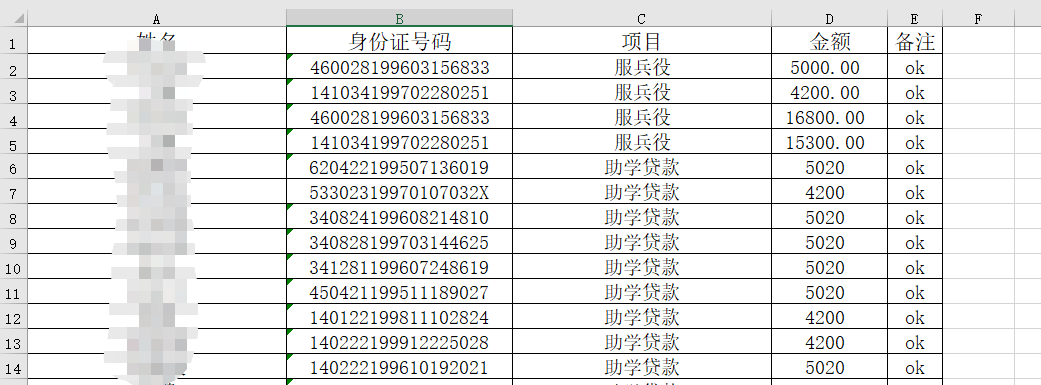
无身份证号.xlsx
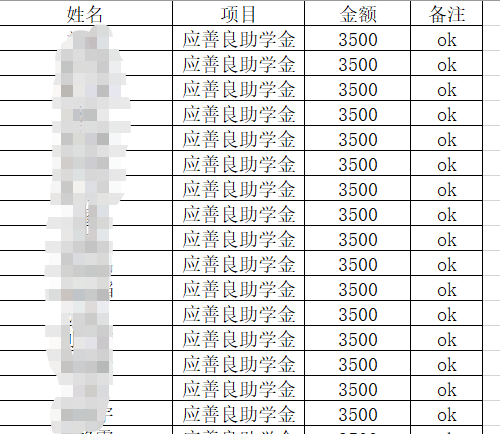
需求
分别统计有身份证号和无身份证号两个文件中每个人获得奖学金的类型和总金额
2. 代码实现
# -*- coding: utf-8 -*- """
Datetime: 2020/01/15
Author: Zhang Yafei
Description:
"""
import pandas as pd class SchorshipStat(object):
def __init__(self, file, idcard_file):
self.df = pd.read_excel(file)
self.df_idcard = pd.read_excel(idcard_file) @staticmethod
def stat_type(row):
return '|'.join(row['项目']) @staticmethod
def stat_amount_sum(row):
return row['金额'].sum() def stat_scholarship_type_total(self, is_save=False, is_print=True):
"""
奖学金统计:身份证号 姓名 奖学金类型 奖学金金额
:param is_save: 是否保存到文件
:param is_print: 是否打印
:return: None
"""
group_df = self.df.groupby(by=['姓名'])
group_df_idcard = self.df_idcard.groupby(by=['身份证号码', '姓名']) df_result = self.grouped_stat(group_df)
df_idcard_result = self.grouped_stat(group_df_idcard) if is_print:
print(df_result)
print(df_idcard_result) if is_save:
with pd.ExcelWriter(path='res/奖学金统计.xlsx') as writer:
df_result.to_excel(excel_writer=writer, sheet_name='无身份证号')
df_idcard_result.to_excel(excel_writer=writer, sheet_name='有身份证号') def grouped_stat(self, group_dataframe):
"""
分组统计函数
:param group_dataframe:
:return: result_df
"""
scholor_type = group_dataframe.apply(self.stat_type)
scholor_amount_sum = group_dataframe.apply(self.stat_amount_sum) result_df = pd.concat(objs=[scholor_type, scholor_amount_sum], axis=1)
result_df.rename(columns={0: '奖学金类型', 1: '奖学金总额'}, inplace=True) return result_df if __name__ == '__main__':
schorship = SchorshipStat(file='data/无身份证号.xlsx', idcard_file='data/有身份证号.xlsx')
schorship.stat_scholarship_type_total(is_print=True, is_save=True)
3. 运行效果
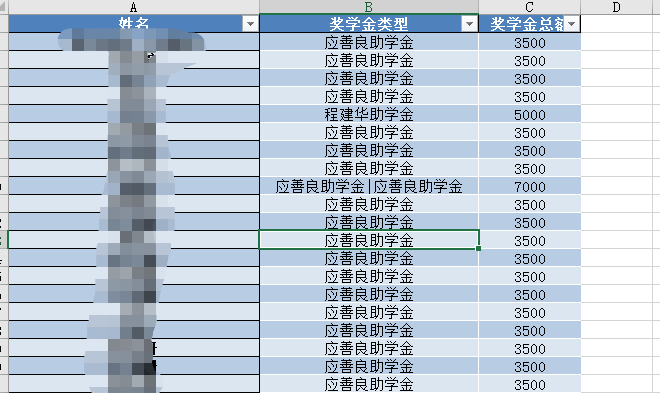

Python实战案例系列(一)的更多相关文章
- python实战案例--银行系统
stay hungry, stay foolish.求知若饥,虚心若愚. 今天和大家分享一个python的实战案例,很多人在学习过程中都希望通过一些案例来试一下,也给自己一点动力.那么下面介绍一下这次 ...
- Python实战案例:这是你见过的最详细的JS加密登录某博
0x00 抓包分析 简单的搜索之后发现,很多参数都是登陆上面这个请求返回的值,这个请求在输入完账号光标到达密码框时就会生成! 0x01 加密逻辑分析 搜索su=可以很快找到加密的位置,上图看到e.su ...
- 源码篇:Python 实战案例----银行系统
import time import random import pickle import os class Card(object): def __init__(self, cardId, car ...
- Python 小案例实战 —— 简易银行存取款查询系统
Python 小案例实战 -- 简易银行存取款查询系统 涉及知识点 包的调用 字典.列表的混合运用 列表元素索引.追加 基本的循环与分支结构 源码 import sys import time ban ...
- 盘它!基于CANN的辅助驾驶AI实战案例,轻松搞定车辆检测和车距计算!
摘要:基于昇腾AI异构计算架构CANN(Compute Architecture for Neural Networks)的简易版辅助驾驶AI应用,具备车辆检测.车距计算等基本功能,作为辅助驾驶入门级 ...
- Python实战:美女图片下载器,海量图片任你下载
Python应用现在如火如荼,应用范围很广.因其效率高开发迅速的优势,快速进入编程语言排行榜前几名.本系列文章致力于可以全面系统的介绍Python语言开发知识和相关知识总结.希望大家能够快速入门并学习 ...
- Python实战:Python爬虫学习教程,获取电影排行榜
Python应用现在如火如荼,应用范围很广.因其效率高开发迅速的优势,快速进入编程语言排行榜前几名.本系列文章致力于可以全面系统的介绍Python语言开发知识和相关知识总结.希望大家能够快速入门并学习 ...
- 屌炸天实战 MySQL 系列教程(二) 史上最屌、你不知道的数据库操作
此篇写MySQL中最基础,也是最重要的操作! 第一篇:屌炸天实战 MySQL 系列教程(一) 生产标准线上环境安装配置案例及棘手问题解决 第二篇:屌炸天实战 MySQL 系列教程(二) 史上最屌.你不 ...
- 《Python爬虫学习系列教程》学习笔记
http://cuiqingcai.com/1052.html 大家好哈,我呢最近在学习Python爬虫,感觉非常有意思,真的让生活可以方便很多.学习过程中我把一些学习的笔记总结下来,还记录了一些自己 ...
随机推荐
- MySQL数据库SUBSTRING_INDEX的运用
一.如何运用SUBSTRING_INDEX截取address的省市区 二.应用SUBSTRING_INDEX函数进行多次嵌套截取 SELECT SUBSTRING_INDEX(t1.`address` ...
- mrctf2020_shellcode_revenge(可见符shellcode)!!!!
第一次碰到这种题目,需要用可见符shellcode来做 题目我就不放了,我认为网上大佬会比我说的更加详细 [原创]纯字母shellcode揭秘-软件逆向-看雪论坛-安全社区|安全招聘|bbs.pedi ...
- 测试开发实战[提测平台]17-Flask&Vue文件上传实现
微信搜索[大奇测试开],关注这个坚持分享测试开发干货的家伙. 先回顾下在此系列第8次分享给出的预期实现的产品原型和需求说明,如下图整体上和前两节实现很相似,只不过一般测试报告要写的内容可能比较多,就多 ...
- GET与POST的比较
HTTP 方法:GET 对比 POST HTTP 消息 标签列表(字母排序) 两种最常用的 HTTP 方法是:GET 和 POST. 什么是 HTTP? 超文本传输协议(HTTP)的设计目的是保证客户 ...
- CF1144A Diverse Strings 题解
Content 我们定义一个字符串是合法的,当且仅当这个字符串是"连续排列"(按照字母表顺序排序).现在给出 \(n\) 个字符串 \(s_1,s_2,s_3,...,s_n\), ...
- linux下记录入站请求
将内网机器通过frp映射到公网后,内网主机受到大量ssh爆破攻击,攻击来源为frp的服务端,仅在内网机器上无法追踪到真实的攻击来源的ip.下面记录了在frp服务端监控指定端口的入站数据,找到真正的攻击 ...
- 200行代码理解Asp.Net Core
转自https://www.cnblogs.com/xiandnc/p/11480735.html
- Various methods for capturing the screen
Explains techniques for capturing the screen programmatically. Download GDI source code - 72.1 Kb Do ...
- ajaxFileUpload上传文件成功后却无法解析服务器返回的json数据
可能是应该返回内容带了标签,过滤下 var index=data.indexOf("<"); if (index!=-1){ data=data.substring(0,in ...
- JAVA实现QQ第三方登录
首先在QQ互联: https://connect.qq.com/manage.html 申请账号,并且进行资料审核,同时创建应用(设置回调地址) 申请应用完后,会有app_ID.app_KEY等参数 ...
